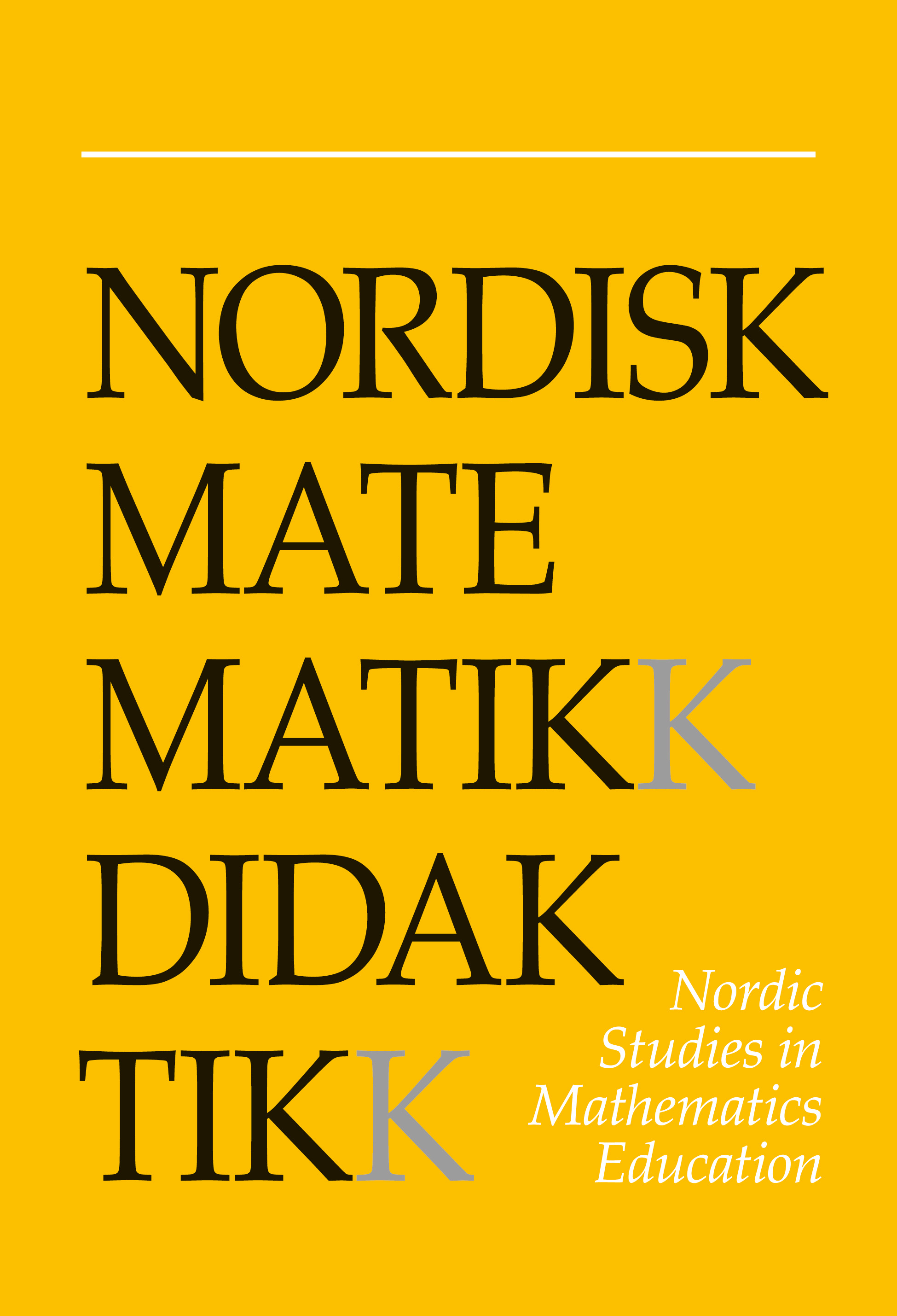Effective mathematical communication in play-based activities: a case study of a Norwegian preschool
DOI:
https://doi.org/10.7146/nomad.v26i2.149165Abstract
This article focuses on effective mathematical communication in preschool. Based on a qualitative case study of a Norwegian preschool, we explore how visual mediators, gestures and mathematical concepts support effective mathematical communication in play-based activities. The article shows how these modes, and the links between them, were crucial for establishing effective communication. Visual mediators, gestures and mathematical concepts functioned as means for making the focal projects and the contexts explicit in the conversations, and thus for communicating effectively.
References
Björklund, C. (2008). Toddlers' opportunities to learn mathematics. International Journal of Early Childhood, 40 (1), 81-95. https://doi.org/10.1007/BF03168365
Björklund, C., Magnusson, M. & Palmér, H. (2018). Teachers' involvement in children's mathematizing - beyond dichotomization between play and teaching. European Early Childhood Education Research Journal, 26 (4), 469- 480. https://doi.org/10.1080/1350293X.2018.1487162
Carlsen, M. (2013). Engaging with mathematics in the kindergarten. Orchestrating a fairy tale through questioning and use of tools. European Early Childhood Education Research Journal, 21 (4), 502-513. https://doi.org/10.1080/1350293X.2013.845439
Carlsen, M., Erfjord, I., Hundeland, P. S. & Monaghan, J. D. (2016). Kindergarten teachers' orchestration of mathematical activities afforded by technology: agency and mediation. Educational Studies in Mathematics, 93 (1), 1-17. https://doi.org/10.1007/s10649-016-9692-9
Clements, D. H. & Sarama, J. (2007). Effects of a preschool mathematics curriculum: summative research on the Building blocks project. Journal for Research in Mathematics Education, 38 (2), 136-163.
Cobb, P. (1994). Where is the mind? Constructivist and sociocultural perspectives on mathematical development. Educational Researcher, 23 (7), 13-20. https://doi.org/10.2307/1176934
Corneille, B. (1997). Early childhood corner: recognizing the mathematics. Teaching Children Mathematics, 4 (2), 112-115. https://doi.org/10.5951/TCM.4.2.0112
Creswell, J. W. & Poth, C. N. (2016). Qualitative inquiry and research design: choosing among five approaches. SAGE.
Doverborg, E. & Samuelsson, I. P. (2000). To develop young children's conception of numbers. Early Child Development and Care, 162 (1), 81-107. https://doi.org/10.1080/0300443001620107
Flottorp, V. (2010). Hvordan kommer matematisk meningsskaping til syne i barns lek? En casestudie. Nordisk Barnehageforskning, 3 (3), 95-104. https://doi.org/10.7577/nbf.278
Fosse, T. (2016). What characterises mathematical conversation in a Norwegian kindergarten? Nordic Studies in Mathematics Education, 21 (4), 135-153.
Ginsburg, H. & Seo, K. H. (2004). What is developmentally appropriate in early childhood mathematics education? Lessons from new research. In D. H. Clements & J. Sarama (Eds.), Engaging young children in mathematics: standards for early childhood mathematics education (pp. 91-104). Routledge.
Ginsburg, H. P. (2006). Mathematical play and playful mathematics: a guide for early education. In R. M. Golinkoff, D. G. Singer & K. Hirsh-Pasek (Eds.), Play = learning: how play motivates and enhances children's cognitive and social-emotional growth (pp. 145-165). Oxford University Press. https://doi.org/10.1093/acprof:oso/9780195304381.003.0008
Halldèn, O. (1999). Conceptual change and contextualization In W. Schnotz, M. Carretero & S. Vosniadou (Eds.), New perspectives on conceptual change (pp. 55-65). Elsevier.
Hundeland, P. S., Carlsen, M. & Erfjord, I. (2014). Children's engagement with mathematics in kindergarten mediated by the use of digital tools. In U. Kortenkamp, B. Brandt, C. Benz, G. Krummheuer, S. Ladel & R. Vogel (Eds.), Early mathematics learning (pp. 207-221). Springer. https://doi.org/10.1007/978-1-4614-4678-1_13
Johansson, M., Lange, T., Meaney, T., Riesbeck, E. & Wernberg, A. (2014). Young children's multimodal mathematical explanations. ZDM, 46 (6), 895-909. https://doi.org/10.1007/s11858-014-0614-y
Kieran, C. (2001). The mathematical discourse of 13-year-old partnered problem solving and its relation to the mathematics that emerges. Educational Studies in Mathematics, 46 (1), 187-228. https://doi.org/10.1023/A:1014040725558
Lithner, J. (2008). A research framework for creative and imitative reasoning. Educational Studies in Mathematics, 67 (3), 255-276. https://doi.org/10.1007/s10649-007-9104-2
Nilsson, P. & Ryve, A. (2010). Focal event, contextualization, and effective communication in the mathematics classroom. Educational Studies in Mathematics, 74, 241-258. https://doi.org/10.1007/s10649-010-9236-7
OECD (2006). Starting strong II: early childhood education and care. OECD.
Oers, B. van (2010). Emergent mathematical thinking in the context of play. Educational Studies in Mathematics, 74 (1), 23-37. https://doi.org/10.1007/s10649-009-9225-x
Radford, L. (2002). The seen, the spoken and the written: a semiotic approach to the problem of objectification of mathematical knowledge. For the Learning of Mathematics, 22 (2), 14-23.
Ryve, A., Nilsson, P. & Pettersson, K. (2013). Analyzing effective communication in mathematics group work: the role of visual mediators and technical terms. Educational Studies in Mathematics, 82 (3), 497-514. https://doi.org/10.1007/s10649-012-9442-6
Saebbe, P.-E. & Mosvold, R. (2016). Initiating a conceptualization of the professional work of teaching mathematics in kindergarten in terms of discourse. Nordic Studies in Mathematics Education, 21 (4), 79-93.
Sfard, A. (2001). There is more to discourse than meets the ears: looking at thinking as communicating to learn more about mathematical learning. Educational Studies in Mathematics, 46, 13-57. https://doi.org/10.1023/A:1014097416157
Sfard, A. (2008). Thinking as communicating. Human development, the growth of discourses and mathematizing. Cambridge University Press. https://doi.org/10.1017/CBO9780511499944
Sfard, A. (2009). What's all the fuss about gestures? A commentary. Educational Studies in Mathematics, 70 (2), 191-200. https://doi.org/10.1007/s10649-008-9161-1
Sfard, A. & Kieran, C. (2001). Cognition as communication: rethinking learning-by-talking through multi-faceted analysis of students' mathematical interactions. Mind, Culture, and Activity, 8 (1), 42-76. https://doi.org/10.1207/S15327884MCA0801_04
Sfard, A. & Lavie, I. (2005). Why cannot children see as the same what grown- ups cannot see as different? - early numerical thinking revisited. Cognition and Instruction, 23 (2), 237-309. https://doi.org/10.1207/s1532690xci2302_3
Singer, E. (2013). Play and playfulness, basic features of early childhood education. European Early Childhood Education Research Journal, 21 (2), 172-184. https://doi.org/10.1080/1350293X.2013.789198
Sumpter, L. & Hedefalk, M. (2015). Preschool children's collective mathematical reasoning during free outdoor play. The Journal of Mathematical Behavior, 39, 1-10. https://doi.org/10.1016/j.jmathb.2015.03.006
Trawick-Smith, J., Swaminathan, S. & Liu, X. (2016). The relationship of teacher-child play interactions to mathematics learning in preschool. Early Child Development and Care, 186 (5), 716-733. https://doi.org/10.1080/03004430.2015.1054818
Vygotsky, L. S. (1978). Mind in society : the development of higher psychological processes. Harvard University Press.
Walsh, G., Sproule, L., McGuinness, C., Trew, K., Rafferty, H. & Sheehy, N. (2006). An appropriate curriculum for 4-5-year-old children in Northern Ireland: comparing play-based and formal approaches. Early Years, 26 (2), 201-221. https://doi.org/10.1080/09575140600760003
Downloads
Published
How to Cite
Issue
Section
License

This work is licensed under a Creative Commons Attribution-NonCommercial-ShareAlike 4.0 International License.



